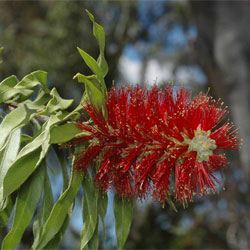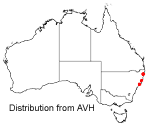Callistemon acuminatus
 |
 |
Some herbaria call this plant Melaleuca flammea
Tapering-leaved Bottlebrush
Callistemon is a frequently seen plant genus in gardens around Australia. It is in the family Myrtaceae and contains over 30 species. The distinctive and showy flowers consisting of massed stamens in terminal spikes gives rise to their common name ‘bottlebrushes’, and although endemic to Australia, they are commonly grown overseas.
 Callistemon
acuminatus is a medium to tall sized shrub with erect habit reaching 2-3
m high by up to 2 m wide. One of its distinctive features are the broad lanceolate
leaves that are drawn to a sharp point, and are up to 10-12cm long. The deep
red/crimson flower spikes are borne in spring to early summer (& also sporadically),
usually in great abundance and up to 10cm long. It has a restricted range and
occurs on the Central-Northern NSW Coast from Port Stephens to the Clarence
River where it is usually found on dry, rocky hillsides and mountainsides in
dry sclerophyll forests and heathlands. Callistemon acuminatus is ROTAP
(Rare or Threatened Australian Plant) listed because of its restricted range
and has horticultural potential because of this and its distinctive appearance.
Callistemon
acuminatus is a medium to tall sized shrub with erect habit reaching 2-3
m high by up to 2 m wide. One of its distinctive features are the broad lanceolate
leaves that are drawn to a sharp point, and are up to 10-12cm long. The deep
red/crimson flower spikes are borne in spring to early summer (& also sporadically),
usually in great abundance and up to 10cm long. It has a restricted range and
occurs on the Central-Northern NSW Coast from Port Stephens to the Clarence
River where it is usually found on dry, rocky hillsides and mountainsides in
dry sclerophyll forests and heathlands. Callistemon acuminatus is ROTAP
(Rare or Threatened Australian Plant) listed because of its restricted range
and has horticultural potential because of this and its distinctive appearance.
Callistemon acuminatus is easily propagated from either seed or cutting. In the majority of Callistemon species, the seed ripens in the capsule and remains on the plant indefinitely until conditions are suitable for the seed capsule to open. In the case of Callistemon acuminatus, the seed capsules, when ripe, open on the shrub and distribute their seeds. Because of this, the shrub must be watched carefully in order to obtain the seed and the capsules should be removed when the first ones open (usually about 12 months after flowering). Seed must be sown on a well-drained medium in spring and summer, and barely covered with a light material such as sieved sand and need to be kept moist until germination occurs. Thin sowing of the seed is advised because the seed is very fine. Seed usually germinates in two to three weeks and growth is often slow for the first few weeks, and this can be sped up by the application of a liquid foliar fertilizer.
Plants can be propagated from cuttings using firm new growth, which should be treated with a rooting hormone. It is recommended that cutting material be taken in February/March. Good results have been gained with the use of bottom heat and misting, if available.
Callistemon acuminatus is adaptable to cultivation where it is a very hardy plant with distinctive large leaves and flowers and like other Callistemon species it attracts native bird species particularly honeyeaters. The plant will withstand very dry conditions although will respond to ample moisture. It is frost hardy plant, will tolerate some coastal exposure and although full sun is recommended it grows well with only partial or morning sun.
Callistemon acuminatus responds well to pruning and dense growth can be achieved by pruning just behind the spent flowers immediately after flowering. This has the added benefit of producing new growth and an increased number of flowers the next season. It also responds well to fairly heavy mulching, and the application of a slow-release low-phosphorus fertilizer in autumn and spring will promote good growth.
The cultivar Callistemon ‘Nabiac Red’, an uncommon species from the Nabiac-Bulahdelah (central NSW coast) area may be a form of C. acuminatus because of its similar leaves and dark red flowers, however it is not widely cultivated.
Text by Mark Williams (2003 Student Botanical Intern)
Name meaning: Callistemon acuminatusCallistemon - from two Greek words, 'kallistos', most beautiful, and 'stemon', a stamen; acuminatus - Latin, acuminate or tapering to a narrow point
(referring to the leaves) |
References
Blombery, A.M. (1955) Native Australian Plants : Their propagation and cultivation.
Wrigley, J. W. & M. Fagg. (1993) Bottlebrushes, Paperbarks and Tea Trees.
MacDonald, G., A. Talbot, N. Peate, D. Williams, M. Gavin. (1990) Grow What Where: Australian Plant Study Group.
'Callistemon (Bottlebrushes)' Australian National Botanic Gardens web site:
www.anbg.gov.au/callistemon/index.html'Clarence Rare Plant Species Information' web site:
www.nor.com.au/environment/clarencecatchment/vegetation/rares/rarein.htm
![An Australian Government Initiative [logo]](/images/austgovt_brown_90px.gif)

